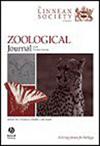神经总科(足形亚目)分类与系统发育的综合研究
IF 2.8
2区 生物学
Q1 ZOOLOGY
引用次数: 0
摘要
对来自澳大利亚塔斯马尼亚州Satan’s Lair的Australonura wellington、Womersleymeria afft . bicornis和Megalanura afft . Tasmania的有丝分裂基因组进行了新的测序和组装,并对它们的特征进行了详细的分析。基于线粒体基因组,提出了包括37种足形目的系统发育。惠灵顿Australonura wellingtonia与湖南龙布塔努拉(Rambutanura hunanensis)放在一起,双角角鼩鼱(W. affer . bicornis)和塔斯马尼亚鼩鼱(M. affer . tasmaniae)放在一起,支持度都很高。我们的结果恢复了Neanuroidea是单系的,绝对支持度最高。Holacanthella duospinosa是巨弹虫属的一种,是新神经科中最早的分支种。仅有的一种短口蝇(Brachystomella parvula)与其他蛛科物种归为一类,质疑其家族地位。我们还重新描述了a . wellingtonia (Womersley, 1936),使用了一种新的方法来记录跳尾的形态,即使用共聚焦显微镜。这里详细介绍了用于标本制备的方法,以方便将来的再现性。本文根据所得到的系统发育假说,讨论了神经总纲中跳跃器官的减少。本文章由计算机程序翻译,如有差异,请以英文原文为准。
An integrated taxonomic and phylogenetic study of Neanuroidea (Poduromorpha)
The mitogenomes of Australonura wellingtonia, Womersleymeria aff. bicornis, and Megalanura aff. tasmaniae from Satan’s Lair, Tasmania, Australia, are newly sequenced and assembled, and their characteristics are detailed. A phylogeny including 37 species of Poduromorpha based on mitochondrial genomes is also presented. Australonura wellingtonia was placed together with Rambutanura hunanensis, and W. aff. bicornis and M. aff. tasmaniae were placed together, all with high support. Our results recovered Neanuroidea as monophyletic with the highest absolute support. Holacanthella duospinosa, a species belonging to the genus of giant springtails, was the earliest branching species within the Neanuroidea clade. The only sampled Brachystomellidae species (Brachystomella parvula) grouped with other Neanuridae species, questioning its family status. We also redescribe the species A. wellingtonia (Womersley, 1936) using a new approach to morphological documentation of springtails, which uses confocal microscopy. The methodology used for specimen preparation is detailed here to facilitate future reproducibility. The reduction of the jumping apparatus within the clade Neanuroidea is discussed here based on the phylogenetic hypothesis obtained.
求助全文
通过发布文献求助,成功后即可免费获取论文全文。
去求助
来源期刊
CiteScore
6.50
自引率
10.70%
发文量
116
审稿时长
6-12 weeks
期刊介绍:
The Zoological Journal of the Linnean Society publishes papers on systematic and evolutionary zoology and comparative, functional and other studies where relevant to these areas. Studies of extinct as well as living animals are included. Reviews are also published; these may be invited by the Editorial Board, but uninvited reviews may also be considered. The Zoological Journal also has a wide circulation amongst zoologists and although narrowly specialized papers are not excluded, potential authors should bear that readership in mind.

 求助内容:
求助内容: 应助结果提醒方式:
应助结果提醒方式:


